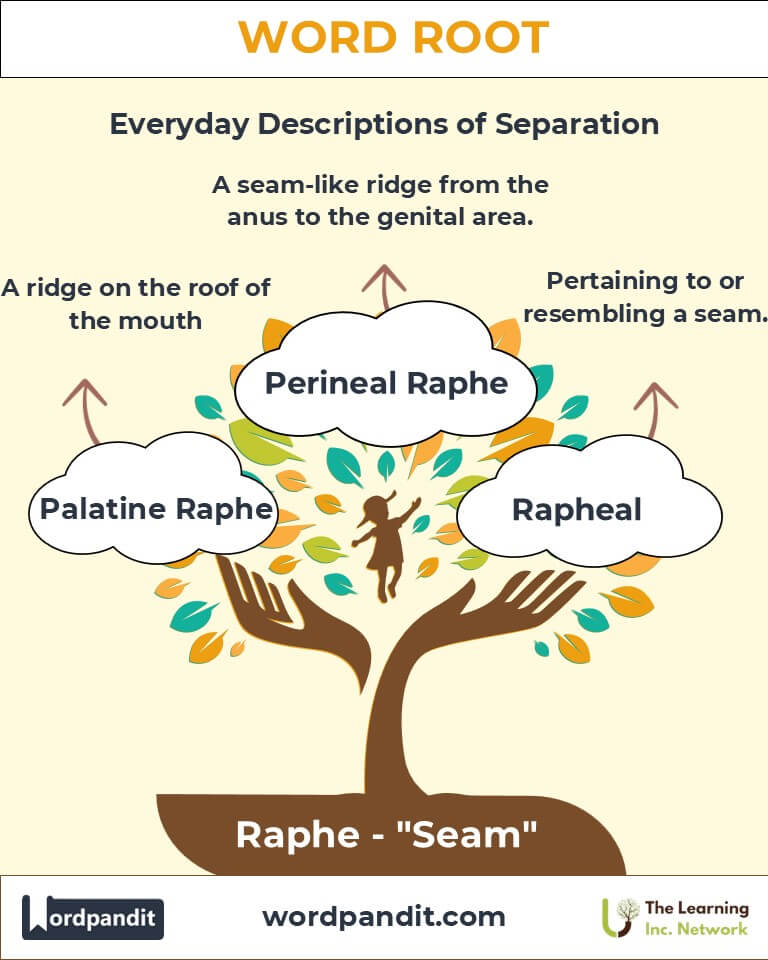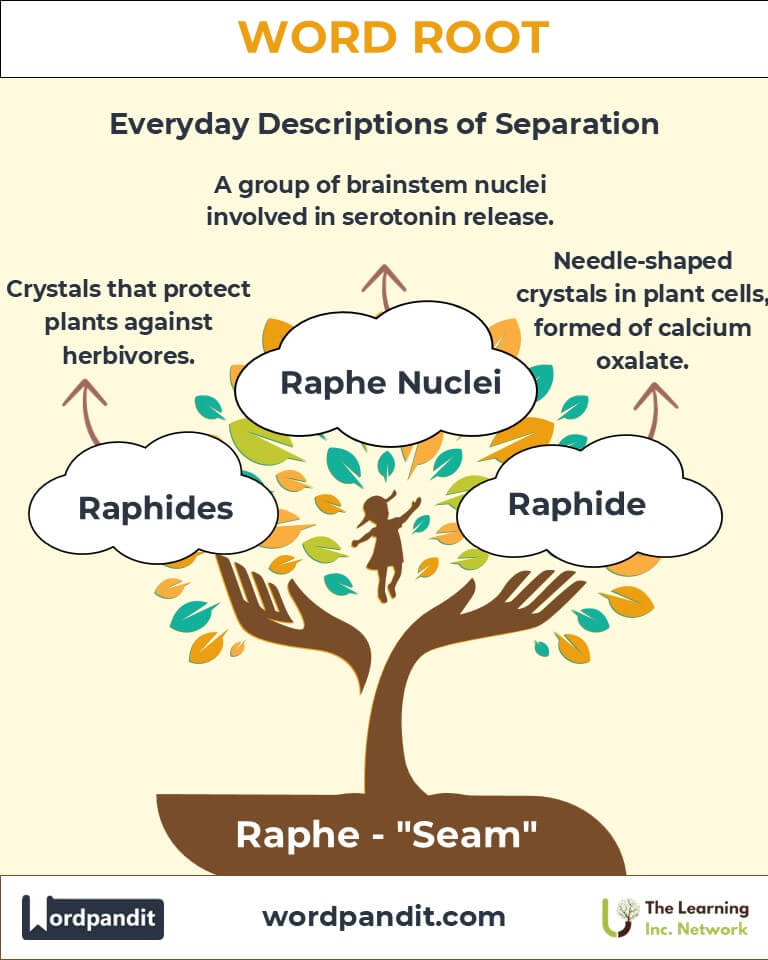Raphe: The Seam Connecting Language and Life
Discover the intricate beauty of the word root "Raphe," derived from the Greek for "seam." This root provides a linguistic thread weaving through anatomy, botany, and beyond. From its role in biological systems to its evocative imagery of joining and division, "Raphe" embodies the essence of connection and structure.

Table of Contents
- Introduction: The Essence of Raphe
- Etymology and Historical Journey
- Mnemonic: Unlocking the Power of Raphe
- Common Raphe-Related Terms
- Raphe Through Time
- Raphe in Specialized Fields
- Illustrative Story: Raphe in Action
- Cultural Significance of the Raphe Root
- The Raphe Family Tree
- FAQs about the Raphe Word Root
- Test Your Knowledge: Raphe Mastery Quiz
- Conclusion: The Living Legacy of Raphe
Introduction: The Essence of Raphe
At its core, the root "Raphe" signifies a "seam" or "ridge," reflecting its Greek origins. Pronounced "ray-fee" or "rah-fee," this root finds its place in diverse scientific and anatomical terms. Whether describing the median line of the human body or the connecting tissues of plants, "Raphe" illustrates the artful joining of structures. Its application underscores the importance of unity in complexity.

Etymology and Historical Journey
The term "Raphe" originates from the Greek word ῥαφή (rhaphe), meaning "seam" or "suture." Ancient anatomists used the term to describe prominent ridges in the human body, such as the perineal raphe. Over centuries, the word transcended its anatomical roots, appearing in botany to describe structural ridges like those on seeds, exemplified by the raphe of an ovule.
Mnemonic: Unlocking the Power of Raphe
Imagine a delicate thread stitching two fabrics together, forming a seamless ridge. This visual encapsulates the essence of "Raphe" as a connector and divider.
Mnemonic Device:
“Raphe stitches life’s designs, linking form and function in a seamless line.”
Common Raphe-Related Terms
- Rapheal (ray-fee-uhl): Pertaining to or resembling a seam.
Example: "The rapheal structure of the ovule aids in nutrient transfer." - Raphide (raf-ide): Needle-shaped crystals in plant cells, often formed of calcium oxalate.
Example: "Raphides in taro leaves can cause irritation when ingested raw." - Perineal Raphe (per-in-ee-uhl ray-fee): The seam-like ridge running from the anus to the genital area.
Example: "The perineal raphe is a distinguishing feature in mammalian anatomy." - Palatine Raphe (pal-uh-tine ray-fee): A ridge on the roof of the mouth.
Example: "The palatine raphe forms during fetal development as the palate fuses." - Raphe Nuclei (ray-fee noo-clee-eye): A group of nuclei in the brainstem involved in serotonin release.
Example: "The raphe nuclei play a critical role in mood regulation."
Raphe Through Time
- Early Applications: Ancient anatomists used "Raphe" to describe visible ridges in the body, emphasizing its structural and functional significance.
- Modern Relevance: In botany, the term evolved to describe ovular ridges, reflecting advancements in plant morphology studies. Neurological discoveries tied "Raphe" to brain structures, enhancing our understanding of emotional and physiological regulation.
Raphe in Specialized Fields
- Anatomy: Perineal Raphe: A developmental marker in mammals.
- Botany: Raphide: Protects plants against herbivores due to its sharp, needle-like form.
- Neuroscience: Raphe Nuclei: Central to serotonin pathways, impacting mood, sleep, and pain perception.
Illustrative Story: Raphe in Action
Dr. Mei, a neurologist, focused her research on the raphe nuclei and its role in depression. Inspired by her garden's vibrant plants, she also studied raphides, observing their protective function against pests. These parallel studies on "seams" in the brain and plants highlighted the interconnectedness of life, where "Raphe" wove a tapestry of science and nature.
Cultural Significance of the Raphe Root
The concept of a seam has deep cultural resonance, symbolizing unity and division. From stitches in textiles to ridges in anatomy, "Raphe" represents the delicate balance between joining and separating, echoing themes in art, literature, and philosophy.

The Raphe Family Tree
- Rhaphe (Greek: "seam"):
Example: Raphides in botany. - Rhaptein (Greek: "to sew"):
Example: Rhapsody (originally meaning a stitched-together song). - Sutura (Latin: "suture"):
Example: Cranial sutures in the human skull.

FAQs About the Raphe Word Root
Q: What does "Raphe" mean?
A: "Raphe" means "seam" or "ridge," derived from the Greek word "rhaphe." It signifies a connection or line of union, commonly used in anatomy, botany, and neuroscience to describe ridges or seams in structures.
Q: What are Raphe nuclei?
A: Raphe nuclei are clusters of neurons in the brainstem involved in serotonin release. They play a significant role in regulating mood, sleep, and emotional responses.
Q: How is "Raphe" used in botany?
A: In botany, "Raphe" describes a ridge or seam on seeds, particularly in ovules. It facilitates nutrient transfer and contributes to seed development.
Q: What is the palatine raphe?
A: The palatine raphe is a seam-like ridge on the roof of the mouth that forms during fetal development as the palate fuses. It is a key feature in oral anatomy.
Q: How is "Raphe" symbolically significant?
A: Symbolically, "Raphe" represents unity and division, much like a seam that joins yet delineates. It appears in art, philosophy, and literature to evoke themes of connection and contrast.
Test Your Knowledge: Raphe Word Root Quiz
1. What does "Raphe" mean?
2. What is the function of the Raphe nuclei?
3. How is "Raphe" relevant in botany?
4. What does the palatine raphe signify?
5. How is "Raphe" symbolically significant?
Conclusion: The Living Legacy of Raphe
The root "Raphe" epitomizes the artistry of connection, from anatomical ridges to botanical defenses. As a symbol of unity and division, it bridges disciplines and inspires appreciation for life's seamless structures. By exploring "Raphe," we embrace the intricate seams that shape our world, connecting science, culture, and the natural world.












